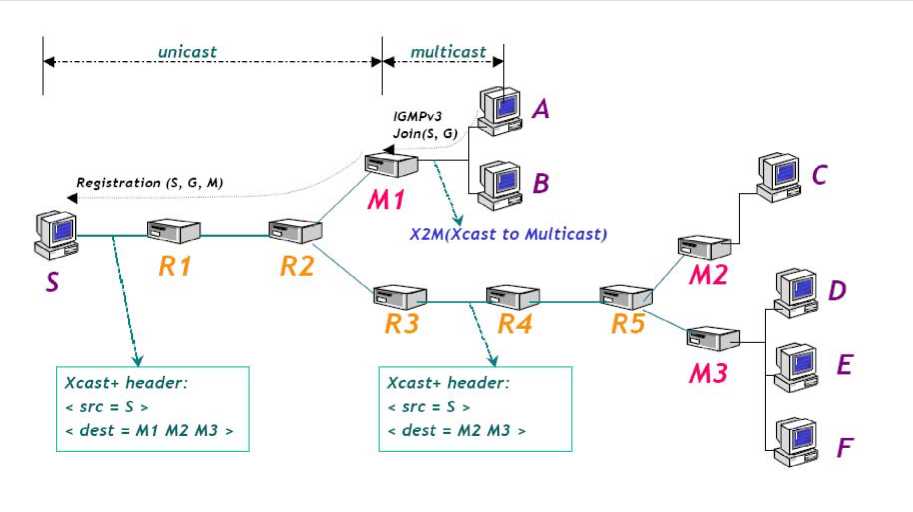M1, M2 and M3 are called Designated Routers (DRs), and they will send a registration
message to the sender S. The registration message consists of Source address S, Group
address G and its own address. When sender (S) wants to send a data packet to the receivers,
the sender encodes the DRs known to the sender (M1,M2 and M3) into the Xcast+ data
packet. The process in the intermediate nodes is the same as in Xcast discussed before. When
the packet is received by the DRs, they send the data packets to the receivers by multicasting.

Figure 3.2 Xcast+ data packet delivery [10].
As discussed before, Xcast+ develops a few extensions to Xcast, and encodes the DRs in the
data packet instead of receivers, and then it uses Xcast to Multicast (X2M) at the DRs. These
extensions bring some benefits:
• Xcast+ is suitable for increasing the number of receivers in the subnet. This happens
because the data packet encodes the DRs instead of receivers, and by default the number
of DRs are less than or equal to receivers.
• Receivers at Xcast+ do not need any additional control messages to join the session. The
receiver is capable of running IGMP, which means that it is capable of joining the Xcast+
session.
38
More intriguing information
1. Evaluating the Success of the School Commodity Food Program2. Does adult education at upper secondary level influence annual wage earnings?
3. The storage and use of newborn babies’ blood spot cards: a public consultation
4. STIMULATING COOPERATION AMONG FARMERS IN A POST-SOCIALIST ECONOMY: LESSONS FROM A PUBLIC-PRIVATE MARKETING PARTNERSHIP IN POLAND
5. Measuring Semantic Similarity by Latent Relational Analysis
6. The name is absent
7. Comparative study of hatching rates of African catfish (Clarias gariepinus Burchell 1822) eggs on different substrates
8. Skills, Partnerships and Tenancy in Sri Lankan Rice Farms
9. Growth and Technological Leadership in US Industries: A Spatial Econometric Analysis at the State Level, 1963-1997
10. Volunteering and the Strategic Value of Ignorance